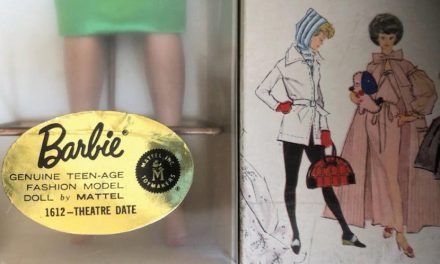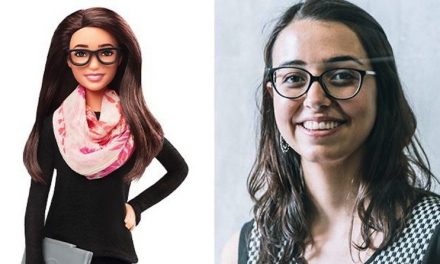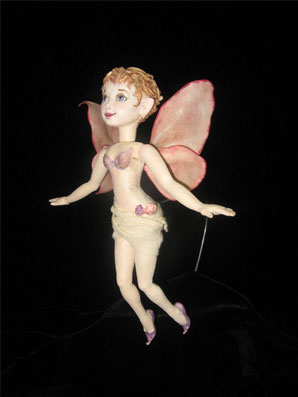Kissing under the mistletoe…decorating with evergreen wreaths, silver bells and red holly…baking sugar cookies…brightly wrapped surprises waiting to be opened… singing carols by a crackling fire… The holiday season is upon us, bringing beloved and time-honored traditions, memories and goodies in its festive wake. This year—thanks to a collaboration between the New York City Ballet (NYCB) and the Tonner Doll Co. (TDC) that brings a new expression to a beloved symbol of the season—all good doll collectors (if you’ve been naughty, there’s still hope) can look forward to a delightful gift.
In celebration of its sponsorship of the 2006 Nutcracker Family Benefit supporting NYCB and its official school, the School of American Ballet, TDC is unveiling graceful ballerina dolls. The collection’s designs are based on and inspired by the original costumes of NYCB’s production of George Balanchine’s The Nutcracker™.
The NYCB dolls, approximately 16 inches tall, boast multiple articulated joints, including bending wrists. Dolls are sculpted with stationary en pointe feet (one style is made with standard high-heel arched fashion feet) and feature a smaller bustline than traditional Tyler-style 16-inch fashion dolls. The Emilie head sculpt is used on all 16-inch dolls in the debut NYCB collection; it is not the same as the Cinderella’s Wicked Stepsister Euphemia head sculpt, which is also a new sculpt.
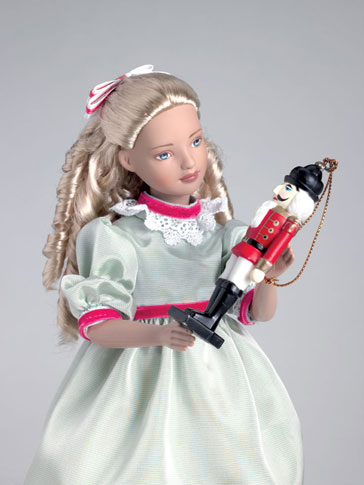 The dolls will help bring the ballet’s magical fantasy into collectors’ homes and recapture fond childhood memories of the holiday ballet, and all the excitement and anticipation this special season brings. While the 1892 version of The Nutcracker is now the most popular, it was the least well known of Tschaikovksy’s ballets until George Balanchine staged his adaptation in 1954. A resounding success, George Balanchine’s The Nutcracker™ has become an enchanting introduction in the artistry and grace of the ballet for generations of children.
The dolls will help bring the ballet’s magical fantasy into collectors’ homes and recapture fond childhood memories of the holiday ballet, and all the excitement and anticipation this special season brings. While the 1892 version of The Nutcracker is now the most popular, it was the least well known of Tschaikovksy’s ballets until George Balanchine staged his adaptation in 1954. A resounding success, George Balanchine’s The Nutcracker™ has become an enchanting introduction in the artistry and grace of the ballet for generations of children.
The ballet also marked one of the most important artistic collaborations of the 20th century—that of George Balanchine and the great costume designer, Barbara Karinska. Beyond music and choreography, production design can be a signature element of a ballet. According to Robert Daniels, NYCB’s managing director of marketing and communications, the “leotard ballets” or the “black and white ballets” serve as visual signatures. “The dancers are costumed in black and white leotards, and the backdrop for the ballet is most often a deep blue scrim,” he notes.
“George Balanchine’s The Nutcracker™ is a perfect example of the other extreme in the NYCB repertoire as it has an opulent production design, with lavish sets, and hundreds of costumes of all shapes, sizes and colors,” Daniels continues. “A decision to re-costume a ballet is an artistic decision made by the ballet’s choreographer. Sometimes costumes are remade, but not redesigned. In a ballet like George Balanchine’s The Nutcracker™, for example, the company still uses most of the original designs that Karinska created for the original 1954 production.”
Karinska’s designs for George Balanchine’s The Nutcracker™ “clearly merit being memorialized as they are an integral part of a work that has had an extraordinary impact on the dance world,” Daniels notes. And who better to memorialize the costumes and capture the Balanchine NYCB vision than Robert Tonner, who has done so much to elevate the quality of miniature couture?
On December 9, 2006, when NYCB and the School of American Ballet present their annual Nutcracker Family Benefit, TDC will be the proud sponsor. It was during the discussions about this sponsorship opportunity that the idea for the NYCB collection emerged. The result: a three-year license enabling TDC to reproduce costumes from any of the ballets in the NYCB repertoire costumed by Madame Karinska.
“We are also allowed to do costumes outside the ballet-based costumes,” Tonner explains. “They understand our need to develop a fuller line. We certainly will try to keep the flavor of the NYCB in all that we do, and what we do will be part of the NYCB collection.”
The production of this specialized collection has enabled Tonner to employ the 16-inch fashion doll body he first created for Tyler Wentworth. In doing so, however, the body required some re-engineering to more accurately capture a ballerina’s style and grace. For the collection, Tonner opted for the small bust torso developed for the Memoirs of a Geisha collection and the bending wrist articulation developed for Tyler.
“We did have to develop new legs,” Tonner notes. “However, NYCB was with us every step of the way to assure we achieved the right look with the en pointe feet and the turned out leg. “I have always wanted to do a ballerina. I love ballet. The dancers are amazing and the stories and costumes are perfect for dolls,” Tonner declares. “Sometimes things just fall into place when they are supposed to. Until we were asked to sponsor the Nutcracker Family Benefit, we didn’t have a ballerina in the line. It was just good fortune we had the body ready for her when the opportunity came.” For the first head sculpt of the NYCB collection, Tonner chose Emilie, the head sculpt used for the limited-edition character created for the 2006 Paris Fashion Doll Festival. (Emilie, however, was produced using the Tyler body and fashion foot, and, as such, remains unique.)
Joe Petrollese, TDC’s design director, visited NYCB at its Lincoln Center home and had a field day studying and photographing the costumes housed there for the details and inspiration necessary for their re-creation.
“Scale is always an issue in re-creating the collection in miniature,” Petrollese explains. “We tried to keep the construction and design as close to how the costumes are actually made. Until you see them up close, you cannot imagine how they are made. For instance, the layers of tulle are hand-stitched together to create an effect that’s as if the skirt is defying gravity.”
Petrollese also notes the decorative detail on some of the actual costumes can be quite large and out of scale in order for them to be seen from the stage. These had to be reduced to proper scale for the miniature reproductions. When collectors receive the “Sugar Plum Fairy” pictured on DOLLS’ Holiday 2007 cover, they can admire the small “sugar plums” and “spun sugar” ribbons on the costume, details that a photograph could not fully capture.
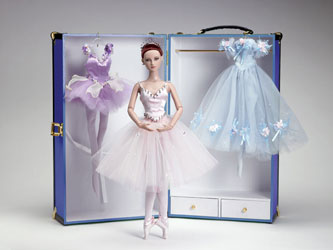 George Balanchine’s The Nutcracker™ will provide much opportunity for humor and delight as the costumes from the visit by Marie and her Nutcracker Prince to the Land of Sweets are reproduced. One can just imagine peppermint candy canes in their stripes of green, white and pink as they dance before the Prince and Princess, marzipan shepherdesses and other “sweet treats” to enchant and inspire. For many of these, collectors will have to wait, however. But, hopefully in time to grace our holiday décor, Tonner and Petrollese have selected to reproduce the two costumes worn by the Sugar Plum Fairy in the ballet. The Sugar Plum Fairy in her pas de deux in the Land of Sweets wears the costume featured on the cover. The other is her romantic long pink tutu, which is a featured part of the FAO exclusive NYCB trunk set. Also available will be the “Dance of the Lady Doll,” which wears the costume appearing in the ballet during the Christmas Eve party. Two of Marie’s costumes are also reproduced: “Marie’s Special Gift,” which she is wearing when her godfather gives her the gift of the Nutcracker, and “Off to the Land of Sweets,” her sleep ensemble for the transition to the dream sequence. Other costumes in the NYCB collection—“L’Hiver,” “Spanish Rose” and “Swan Lake”— were designed by TDC and are not actual reproductions.
George Balanchine’s The Nutcracker™ will provide much opportunity for humor and delight as the costumes from the visit by Marie and her Nutcracker Prince to the Land of Sweets are reproduced. One can just imagine peppermint candy canes in their stripes of green, white and pink as they dance before the Prince and Princess, marzipan shepherdesses and other “sweet treats” to enchant and inspire. For many of these, collectors will have to wait, however. But, hopefully in time to grace our holiday décor, Tonner and Petrollese have selected to reproduce the two costumes worn by the Sugar Plum Fairy in the ballet. The Sugar Plum Fairy in her pas de deux in the Land of Sweets wears the costume featured on the cover. The other is her romantic long pink tutu, which is a featured part of the FAO exclusive NYCB trunk set. Also available will be the “Dance of the Lady Doll,” which wears the costume appearing in the ballet during the Christmas Eve party. Two of Marie’s costumes are also reproduced: “Marie’s Special Gift,” which she is wearing when her godfather gives her the gift of the Nutcracker, and “Off to the Land of Sweets,” her sleep ensemble for the transition to the dream sequence. Other costumes in the NYCB collection—“L’Hiver,” “Spanish Rose” and “Swan Lake”— were designed by TDC and are not actual reproductions.
“I certainly would like to do more with the collection next year, and new characters are part of that plan,” Tonner notes. “By all means, a male dancer is needed.”
Among the offerings for the 2007 collection will be a lovely “Coppelia,” as well as a rehearsal doll. The latter, wearing the NYCB T-shirt and jeans, will be the only fashion-footed doll in the NYCB collection. So, this holiday season, if you can’t make it to your nearest ballet theater production of The Nutcracker, check out the movie version by the same name. With Tonner’s “Sugar Plum Fairy” or “Dance of the Lady Doll” in hand, you will thrill to the rich movement of color across the stage as you dream about the next “must haves” for your collection.

